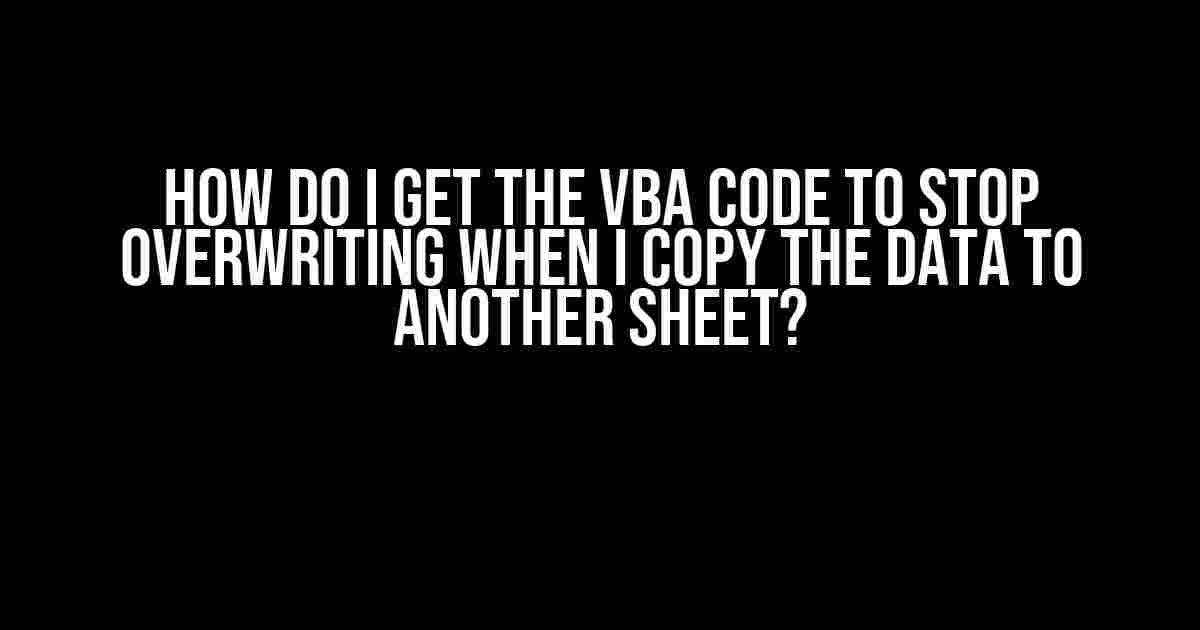Are you tired of dealing with VBA code that insists on overwriting your precious data every time you try to copy it to another sheet? Well, worry no more! In this article, we’ll dive into the world of VBA coding and explore the reasons behind this pesky problem. By the end of this comprehensive guide, you’ll be well-equipped to tame the beast and make your VBA code behave.
What’s causing the overwrite?
Before we dive into the solution, let’s take a step back and understand what’s causing the overwrite in the first place. There are a few common culprits that might be responsible for this issue:
- Improper sheet selection: If your VBA code is not specifically selecting the target sheet before pasting the data, it might be pasting it into the active sheet, overwriting existing data.
- Lack of data range specification: Failing to specify the exact range where you want to paste the data can lead to overwriting existing data.
- Incorrect paste method: Using the wrong paste method, such as `Worksheet.Paste` instead of `Worksheet.Range.Paste`, can cause overwriting issues.
Solution 1: Specify the target sheet and range
Sub CopyData()
Dim sourceRange As Range
Dim targetRange As Range
' Set source range
Set sourceRange = ThisWorkbook.Sheets("SourceSheet").Range("A1:B10")
' Set target range
Set targetRange = ThisWorkbook.Sheets("TargetSheet").Range("A1:B10")
' Copy data
sourceRange.Copy targetRange
End Sub
In this example, we’ve specified the source range (`A1:B10`) on the `SourceSheet` and the target range (`A1:B10`) on the `TargetSheet`. By doing so, we ensure that the data is pasted exactly where we want it to be.
Solution 2: Use the `Worksheet.Range.Paste` method
Another way to avoid overwriting is to use the `Worksheet.Range.Paste` method instead of `Worksheet.Paste`. This method allows you to specify the exact range where you want to paste the data.
Sub CopyData()
Dim sourceRange As Range
Dim targetRange As Range
' Set source range
Set sourceRange = ThisWorkbook.Sheets("SourceSheet").Range("A1:B10")
' Set target range
Set targetRange = ThisWorkbook.Sheets("TargetSheet").Range("A1:B10")
' Copy data
sourceRange.Copy
targetRange.Paste
End Sub
By using `targetRange.Paste`, we’re telling VBA to paste the data into the specified range, rather than overwriting existing data.
Solution 3: Use the `Worksheet.Range.Value` property
A third approach is to use the `Worksheet.Range.Value` property to assign the values from the source range to the target range. This method eliminates the need for copying and pasting altogether.
Sub CopyData()
Dim sourceRange As Range
Dim targetRange As Range
' Set source range
Set sourceRange = ThisWorkbook.Sheets("SourceSheet").Range("A1:B10")
' Set target range
Set targetRange = ThisWorkbook.Sheets("TargetSheet").Range("A1:B10")
' Assign values
targetRange.Value = sourceRange.Value
End Sub
By using `targetRange.Value = sourceRange.Value`, we’re directly assigning the values from the source range to the target range, without any risk of overwriting.
Additional Tips and Tricks
Here are some additional tips to keep in mind when working with VBA code and copying data between sheets:
- Use `Application.ScreenUpdating = False`: This can improve performance and reduce screen flicker when copying large amounts of data.
- Avoid using `Select` and `Activate`: Instead, use explicit references to the sheets and ranges you’re working with.
- Use error handling: Implement error handling to catch any potential issues that might arise during the data copying process.
Conclusion
By following these solutions and tips, you should be able to get your VBA code to stop overwriting data when copying to another sheet. Remember to always specify the target sheet and range, use the correct paste method, and consider using the `Worksheet.Range.Value` property for a more efficient approach. Happy coding!
| Solution | Code Snippet |
|---|---|
| Specify target sheet and range | sourceRange.Copy targetRange |
| Use the `Worksheet.Range.Paste` method | sourceRange.Copy; targetRange.Paste |
| Use the `Worksheet.Range.Value` property | targetRange.Value = sourceRange.Value |
Which solution worked best for you? Do you have any favorite VBA coding tips or tricks to share? Let us know in the comments below!
Frequently Asked Question
Are you tired of your VBA code overwriting precious data when copying it to another sheet? Worry no more! Here are the top 5 FAQs to help you master the art of data copying without the anxiety of overwriting.
Q: Why does my VBA code keep overwriting data when I copy it to another sheet?
A: This common issue usually occurs because the code isn’t specifying the range to paste the data, causing it to default to the active cell. To avoid this, make sure to specify the exact range where you want to paste the data using the Range object, like `Worksheets(“TargetSheet”).Range(“A1:B10”).Value = …`.
Q: How can I copy only the values from one sheet to another without formatting?
A: To copy only the values, use the `Value` property of the Range object, like `Worksheets(“TargetSheet”).Range(“A1:B10”).Value = Worksheets(“SourceSheet”).Range(“A1:B10”).Value`. This will copy the values without any formatting.
Q: Can I use the Clipboard to copy and paste data without overwriting?
A: Yes, you can use the Clipboard to copy and paste data, but it’s not recommended as it can be slow and unreliable. Instead, use the Range object to copy and paste data directly, like `Worksheets(“TargetSheet”).Range(“A1:B10”).Value = Worksheets(“SourceSheet”).Range(“A1:B10”).Value`.
Q: How do I append data to an existing sheet without overwriting?
A: To append data to an existing sheet, use the `ListObject` object to add new rows to the existing data, like `Worksheets(“TargetSheet”).ListObjects(“MyTable”).ListRows.Add`. This will add new rows to the end of the existing data.
Q: Can I use an array to copy and paste data without overwriting?
A: Yes, you can use an array to copy and paste data, especially when working with large datasets. Use the `Range` object to assign the array to a range, like `Worksheets(“TargetSheet”).Range(“A1:B10”).Value = myArray`. This is a fast and efficient way to copy and paste data.

